The History Book Club discussion

This topic is about
A Tale of Two Cities
HISTORICAL FICTION
>
GLOSSARY - A TALE OF TWO CITIES - SPOILER THREAD
date newest »
newest »
 newest »
newest »
 Chapter 12 The Fellow of Delicacy
Chapter 12 The Fellow of Delicacy "... take Miss Manette to Vauxhall Gardens; that failing, to Ranelagh..."
( Gardens)
Vauxhall Gardens
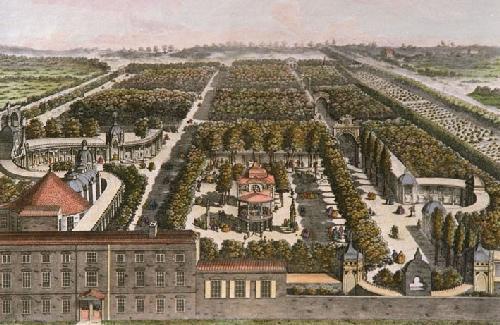
and Ranelagh Gardens
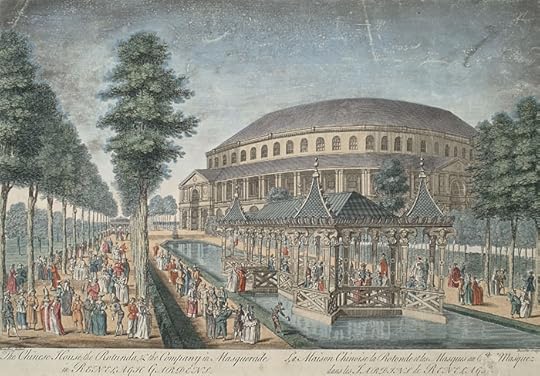
Chapter 13 The Fellow of No Delicacy
"…Mr. Stryver … Devonshire…"
a county in the southwest of England: Devonshire is bordered by the Bristol Channel to the north and the English Channel to the south,
"…and found Lucie at her work, alone. "
Sewing or needlepoint; the word itself (“work”) is a shortened form of “drawn-work, fancy work, lace-work, open-work, etc.” Such work, putting periods of domestic leisure to use, was appropriate for young women in the 18th and 19th centuries.
 Chapter 14 The Honest Tradesman
Chapter 14 The Honest Tradesman"... part of his income was derived from the pilotage of timid women (mostly of a full habit and past the middle term of life)..."
Here, “full habit” presumably refers to the style of dress typical of the timid, middle-aged women Mr. Cruncher conveys across traffic. Women’s clothing in the 18th and 19th centuries tended to include full skirts, large hats, etc. Middle-aged, timid women would not walk briskly at the best of times, and in multiple petticoats they would be even further encumbered.

*
“ 'Why, to be sure!' exclaimed Jerry, recalling the Trial at which he had assisted. 'I’ve seen him. Dead, is he?'
'Dead as mutton,”'returned the other, 'and can’t be too dead. Have ’em out, there! Spies! Pull ’em out, there! Spies!' "

illustration by Phiz, narrative based on the trial and funeral of Francis Henry de la Motte
http://en.wikipedia.org/wiki/François...
*
"...…after shedding his cloak, hat, long hatband, white pocket-handkerchief..."
A long hatband, white handkerchief, and black cloak were all appropriate mourning attire for a man. As the Dictionary of Daily Wants (1859) notes, the hat is the “most prominent article” in male mourning, the largeness of the hatband varying according to the degree of intimacy between the mourner and the deceased.
http://dickens.stanford.edu/tale/issu...
*
"…while the tradesmen hurriedly shut up their shops; for a crowd in those times stopped at nothing, and was a monster much dreaded."
In the 18th century, and especially in the early 1780s, mobs were of considerable concern to London authorities. Mobbing had become a critical form of protest against government policies in the capital city, and 1780 is famous for the Gordon Riots, when a group of some 30,000-50,000 people, led by Lord George Gordon, overran the streets... prisons... and Bank of England and more than 400 people were killed (Johnson 31-2).
http://dickens.stanford.edu/tale/issu...
*
"…with a chimney-sweep driving the hearse … and with a pieman, also attended by his cabinet minister, driving the mourning coach. A bear-leader, a popular street character of the time, was impressed as an additional ornament…"
A chimney-sweep ... was literally a sweeper of chimneys. Children were often employed as sweeps because their small size made them better able to fit inside the chimneys they were cleaning... The chimney-sweeper driving the hearse may or may not be an adult. A pieman... is a kind of itinerant victualler, offering meat, fish, or fruit pies for sale (Sanders 105); and his “cabinet minister” is a facetious name for the person supervising his efforts (a cabinet minister being an advisor or counselor). A “bear-leader” is a man who leads and accompanies a performing bear. Both he and his bear are “impressed” by the crowd – meaning forcibly enlisted – as “additional ornaments” in the procession.
Its destination was the old church of Saint Pancras, far off in the fields.
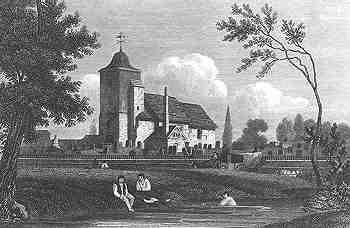
Pancras was a hamlet at the time, the very old church was gothic in design, and it was in the countryside at the time. Many 18th and early 19th century literary people are buried there incluidng Mary Wollstonecraft.
*
"Whether his meditations on mortality had touched his liver, or whether his general health had been previously at all amiss … he made a short call upon his medical advisor..."
Jerry’s “liver,” in its possible susceptibility to “meditations on mortality,” is a kind of figurative organ ... frequently associated with disposition or temperament ... the source of love or the more violent passions. Together with the brain and heart, it is often used metaphorically to represent the vital functions of the body.
http://dickens.stanford.edu/tale/issu...
*
“ '…my wenturs goes wrong tonight…' ”
When Mr. Cruncher, who tends to pronounce “w” like “v,” insists that his “wenturs” are going wrong, he is describing his “ventures” – the pursuits of “a honest tradesman.”
*
“ 'If I don’t, you’ll have short commons to-morrow,' ”
“Commons,” in this sense, are provisions – rations, food. The threat of “short commons” is the threat of an insufficiency.
http://dickens.stanford.edu/tale/issu...
 Chapter 15: Knitting
Chapter 15: Knitting "... his right hand, armed with the knife, will be burnt off before his face; ...
This was actually done to a prisoner, Robert Damiens, who had made an attempt on the life of King, Louis XV in 1757.
http://en.wikipedia.org/wiki/Robert-F...
Again, Dickens represents as typical what was highly unusual. Damiens’s execution in this deliberately anachronistic, medieval manner won sympathy for him he would not otherwise have had, and was an important episode in the drift of public sentiment away from the monarchy. Damiens was the last person to be executed this way in France.
http://dickens.stanford.edu/archive/t...
http://www.executedtoday.com/2008/03/...
*
"... the large-faced King and the fair-faced Queen came in their golden coach, attended by the shining Bulls Eye of their Court.
The Salon de l’oeil de Boeuf (room of the bull’s eye was the anteroom to the king’s apartments at Versailles, where the ritual of the monarch’s levee (a reception held when he arose from bed unfolded daily before a crowd of courtiers and attendants. The royal family also dined there in public view.
http://en.wikipedia.org/wiki/Oeil-de-...
http://en.wikipedia.org/wiki/Palace_o...
*
Chapter 16: Still Knitting
"... when the military drums should be beating to drown a wretched voice ...
The reference is to the execution of King Louis XVI on January 21, 1793. The monarch tried to speak to his people, but at a signal from his executioners, drums drowned out his final words.
http://en.wikipedia.org/wiki/Louis_XV...
*
And as mere human knowledge can split a ray of light and analyse the manner of its composition, so, sublimer intelligences may read in the feeble shining of this earth of ours, every thought and act, every vice and virtue, of every responsible creature on it.
By this time, Sir Isaac Newton’s work on light and optics was already nearly two hundred years old so anyone with rudimentary knowledge of optics – or of prisms – could split light into the colors of the rainbow.
http://dickens.stanford.edu/dickens/a...
*
“There is another spy commissioned for our quarter…”
Historians estimate that there were between 300 and 3,000 spies, commissioned by the police, working at any given time in pre-revolutionary Paris (Maxwell 461). Mercier’s Tableau de Paris (1781-8), one of Dickens’ French sources, describes the extent of organized spying.
*
…the stock of rum and brandy and aniseed.
aniseed is a seed (anise) used as a flavoring, as in the popular French liqueur called “anisette” (Sanders 108)
http://dickens.stanford.edu/dickens/a...
*
"Madame Defarge with her work in her hand was accustomed to pass from place to place and from group to group: a Missionary – there were many like her – such as the world will do well never to breed again. All the women knitted. They knitted worthless things; but, the mechanical work was a mechanical substitute for eating and drinking…

The knitting women here are the famous citoyennes tricoteuses of revolutionary Paris, who would, during the Reign of Terror, take their knitting with them to watch the executions at the guillotine.
http://en.wikipedia.org/wiki/Tricoteuse
*
"... much was closing in about the women who sat knitting, knitting, that they their very selves were closing in around a structure yet unbuilt, where they were to sit knitting, knitting, counting dropping heads.”
Dickens connects the knitting of Madame Defarge and her compatriots with a chief motive of the French Revolution – hunger. And his imagery suggests that this knitting registers the gradual creation – the knitting-together, as it were – of a means to revenge that wrong.
But Thomas Carlyle notes the knitting women, too. :
"...for there are Citoyennes too, thick crowded in the galleries here. Citoyennes who bring their seam with them, or their knitting-needles; and shriek or knit as the case needs; famed Tricoteuses, Patriot Knitters;—Mere Duchesse, or the like Deborah and Mother of the Faubourgs, giving the keynote. It is a changed Jacobin Society; and a still changing. Where Mother Duchess now sits, authentic Duchesses have sat. High-rouged dames went once in jewels and spangles; now, instead of jewels, you may take the knitting-needles and leave the rouge:"
 by
by
 Thomas Carlyle Volume 3 Book Chapter 3.2.V
Thomas Carlyle Volume 3 Book Chapter 3.2.V
 Chapters 18 Nine Days
Chapters 18 Nine DaysIt was when they turned into the welcome shade of the cool old hall, that Mr. Lorry observed a great change to have come over the Doctor; as if the golden arm uplifted there, had struck him a poisoned blow.
He had naturally repressed much, and some revulsion might have been expected in him when the occasion for repression was gone. But, it was the old scared lost look that troubled Mr. Lorry:
“Perhaps the most remarkable example of Dickens's psychiatric insight is the case of Dr. Manette in A Tale of TwoCities. It is remarkable for the accuracy of his account of a case of multiple personality and loss of memory,because it is the most comprehensive of his studies of psychological abnormality, and because it includes an anticipation
of psychotherapy.
“His friend Mr. Lorry now embarked upon the psychotherapy. He thought it best to present Dr. Manette's caseto himself as though it was that of a patient. He described to Dr. Manette someone who had had a great mental shockand who had suffered from a relapse. He led him gradually to the recognition that the case was his own.
“Dr. Manette's analysis proceeds, and he is led to regard his shoemaker's bench as a symbol both of the past and of his neurosis, and to agree to its destruction. " Very strange," says Dickens, "to see what a struggle there was within him." But although Dr. Manette was relieved he was not cured.”
http://www.ncbi.nlm.nih.gov/pmc/artic...
Another thought - "Doctor Manette’s account of his condition (which he and Mr. Lorry discuss as though it were another’s) draws on 18th-century theories of psychology derived from John Locke and developed by David Hartley and others (Maxwell 462)"
http://dickens.stanford.edu/dickens/a...
According to Harold Bloom, other characters who might benefit from a bit of psychiatric care are Jerry Cruncher (rusty fingers), Sydney Carton (self-esteem and drinking), Teresa Defarge (anger issues) and Miss Pross (care-taker syndrome). (the reasons are mine.)
 by
by
 Harold Bloom
Harold Bloom
 Chapter 19 An Opinion
Chapter 19 An Opinion"On the night of the day on which he left the house, Mr. Lorry went into his room with a chopper, saw, chisel, and hammer, attended by Miss Pross carrying a light. There, with closed doors, and in a mysterious and guilty manner, Mr. Lorry hacked the shoemaker’s bench to pieces, while Miss Pross held the candle as if she were assisting at a murder—for which, indeed, in her grimness, she was no unsuitable figure."
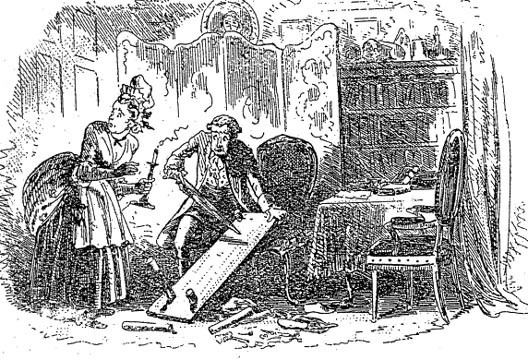
 Chapter 21: Echoing Footsteps
Chapter 21: Echoing Footsteps Saint Antoine had been, that morning, a vast dusky mass of scarecrows heaving to and fro, with frequent gleams of light above the billowy heads, where steel blades and bayonets shone in the sun. A tremendous roar arose from the throat of Saint Antoine, and a forest of naked arms struggled in the air like shrivelled branches of trees in a winter wind:
And from Thomas Carlyle, the same scene:
"On Monday the huge City has awoke, not to its week-day industry: to what a different one! The working man has become a fighting man; has one want only: that of arms."
THomas Carlyle The French Revolution - Chapter 1.5.V.: Give us Arms.
*
"... muskets were being distributed ..."
From Thomas Carlyle, who describes the looting of the government arsenal at the Hotel des Invalides by the sans-culottes (a radical group in France during the time of the Revolution, who then used the weapons to wage war against the state.
And the sans-culottes, wearing iconic Phrygian caps and tricolor cockades.

*
"Deep ditches, double drawbridge, massive stone walls, eight great towers, cannon, muskets, fire and smoke..."
Carlyle begins his account of the storming of the Bastille by conceding that the event “perhaps transcends the talent of mortals” to describe. By concentrating on the role of the fictional Defarges, Dickens mostly steers clear of Carlyle’s panoramic model, but he does borrow these details of the Bastille architecture.
*
"Otherwise. the governor would not be marched to the Hôtel de V ille for judgment"
You can see the governor, about 25% in from the right edge, in this reproduction of a painting by an anonymous observer:
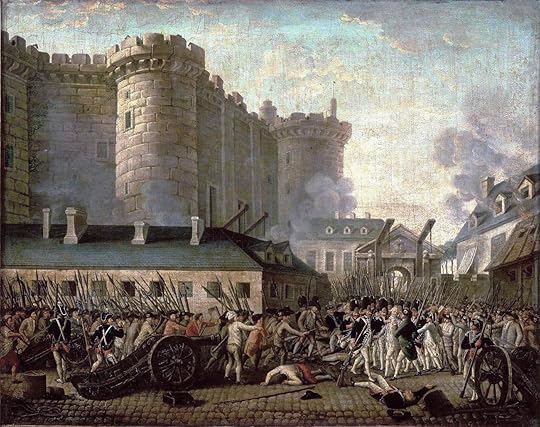
The Marquis de Launay , governor of the Bastille. first negotiated with the mob on July 14, 1789, before rejecting their demands for access to the Bastille’s gunpowder stores. In the confusion, the drawbridge was lowered, and the crowd surged inside; de Launay ordered his soldiers to fire and more than a hundred of the insurgents were killed. When the revolutionaries prevailed, de Launay was marched toward the Hôtel de Ville, and killed on the way. Dickens bestows the honor of that retribution on Madame Defarge.
*
Seven faces of prisoners, suddenly released by the storm that had bum their tomb."
At this point, the Bastille was nearly empty of prisoners, housing only seven old men annoyed by all the disturbance:[4] four forgers, two "lunatics" and one "deviant" aristocrat, the comte de Solages (the Marquis de Sade had been transferred out ten days earlier).
http://en.wikipedia.org/wiki/Storming...
 by
by
 Thomas Carlyle
Thomas Carlyle
 Chapter 22 The Sea Still Rises
Chapter 22 The Sea Still Rises"The short, rather plump wife of a starved grocer, and the mother of two children withal, this lieutenant had already earned the complimentary name of The Vengeance. "
"During the French Revolution, patriotic abstractions such as “The Vengeance” did indeed replace personal names. This renaming, demonstrating support for the revolutionary cause and affirming the end of traditions associated with the ancien régime, extended to public buildings, streets, plazas, etc. For example, the Place de Louis XV in Paris became the Place de la Révolution; the Jardin des Tuileries became the Jardin National; the Palais des Tuileries became the Palais National; and so forth. We can compare the pre-revolutionary names visible on the Plan de la Ville de Paris en 1789 with the succeeding names of the revolutionary period on thePlan de la Ville de Paris, Période Révolutionnaire, 1790-1794."
*
"Defarge came in breathless, pulled off the red cap he wore, and looked around him." This "red cap" appears several times in A Tale of Two Cities.
(See the red caps in message 21)
"The red cap worn by Defarge is the so-called “Phrygian cap” worn by French patriots during the Revolution. The Phrygians were an ancient Asian people, living in what is now Turkey; their conical caps became “caps of liberty” when the style was adopted by freed Roman slaves (as headgear symbolic of their liberation) (Tricolor and Phrygian Cap)."
http://dickens.stanford.edu/dickens/a...
And so the red cap became the Jacobin headwear of choice.
Carlyle calls this "the Phrygian Cap of Liberty" in Volume 2 Book 2.1. Chapter XII of his "The French Revolution: A History."
"...the Phrygian Cap of Liberty! In all Towns, Trees of Liberty also may be planted; with or without advantage. Said we not, it is the highest stretch attained by the Thespian Art on this Planet, or perhaps attainable?"
and again -
"Note too how the Jacobin Brethren are mounting new symbolical headgear: the Woollen Cap or Nightcap, bonnet de laine, better known as bonnet rouge, the colour being red. A thing one wears not only by way of Phrygian Cap-of-Liberty, but also for convenience' sake, and then also in compliment to the Lower-class Patriots and Bastille-Heroes; for the Red Nightcap combines all the three properties. Nay cockades themselves begin to be made of wool, of tricolor yarn: the riband-cockade, as a symptom of Feuillant Upper-class temper, is becoming suspicious. Signs of the times."
Volume 2 Book 2.5, Chapter IX
*
“'Does everybody here recall old Foulon, who told the famished people that they might eat grass, and who died, and went to Hell?'”
Joseph Foullon de Doué was widely accused of rumor accused having said: "If those rascals have no bread, then let them eat hay."
"After the storming of the Bastille on 14 July, aware of the people's hatred, Foullon fled Paris to his friend Antoine de Sartine's house at Viry-Châtillon, a few miles south of the capital. He attempted to spread the news of his death."
http://en.wikipedia.org/wiki/Joseph_F...
The quote was even reported in the Carlyle book:
" 'What will the people do?'—made answer, in the fire of discussion, 'The people may eat grass:" hasty words, which fly abroad irrevocable,—and will send back tidings! ' "
Volume 1, Book 1.1, Chapter 1.3.VIII.
" …the men sternly calling out to have him killed with grass in his mouth. Once, he went aloft, and the rope broke, and they caught him shrieking; then, the rope was merciful and held him, and his head was soon upon a pike, with grass enough in the mouth for all Saint Antoine to dance at the sight of".
Dickens’ account of Foulon’s lynching follows but simplifies Carlyle’s report:
Volume 1, Book 1.1, Chapter 1.5.IX.
 by
by
 Thomas Carlyle
Thomas Carlyle
 Chapter 23 Fire Rises
Chapter 23 Fire RisesThus it was, however; and the last drop of blood having been extracted from the flints, and the last screw of the rack having been turned so often that its purchase crumbled, and it now turned and turned with nothing to bite, Monseigneur began to run away from a phenomenon so low and unaccountable."
Monseigneur appears to be leaving France in the “First Emigration” of July, 1789 – the first flight of the aristocracy after the fall of the Bastille.
*
"As it advanced, the mender of roads would discern without surprise, that it was a shaggy-haired man, of almost barbarian aspect, tall, in wooden shoes that were clumsy even to the eyes of a mender of roads, grim, rough, swart, steeped in the mud and dust of many highways, dank with the marshy moisture of many low grounds, sprinkled with the thorns and leaves and moss of many byways through woods. "
This “shaggy-haired man, of almost barbarian aspect” is an agent of destruction in the “Great Fear," the period between July 20 and August 6, 1789, during which – after the fall of the Bastille – a number of châteaus were burned down (Maxwell 465). Dickens follows Carlyle’s account of this period, in which the destruction of aristocratic property is largely attributed to the accumulated rage of the oppressed common people.
More recent historians have claimed the destruction was not so much systematic as like an explosive fire.
http://dickens.stanford.edu/dickens/a...
 by
by
 Thomas Carlyle
Thomas Carlyle
 Chapter 24 Drawn to the Loadstone Rock
Chapter 24 Drawn to the Loadstone Rock"...reading the Lord ‘s Prayer backwards...
In folklore, this is an invocation of the Devil.
"For, the footsteps had become to their minds [in Soho Square] as the footsteps of a people, tumultuous under a red flag and with their country declared in danger, changed into wild beasts, by terrible enchantment long persisted in."
This is the red flag of martial law, introduced during the French Revolution on July 17, 1791, when a crowd coming to sign a petition to depose King Louis XVI (who had just been caught fleeing Paris with his family [June 20-25, 1791] and forced to return) became violent in the Champ de Mars.
http://dickens.stanford.edu/dickens/a...
*
"Royalty was gone; had been besieged in its Palace and “suspended,” when the last tidings came over. "
The family of Louis XVI and Marie Antoinette had been confined to the Tuileries since June of 1791 when they had tried to escape France. They were caught, returned as prisoners, the King was suspended from office, and they were both ultimately beheaded.
*
“' …who can say that Paris is not set afire to-day, or sacked to-morrow!' ”
Mr. Lorry’s concern that Paris may soon be set alight or sacked is well-founded, as France had been facing the threat of foreign invasion since August of the previous year (French Revolution xxxviii-ix), and had declared itself in danger on July 22, 1792.
http://dickens.stanford.edu/dickens/a...
The Prison of the Abbaye:

 Book 3: The Track of a Storm
Book 3: The Track of a StormChapter 1: In Secret
" Every town-gate and village taxing-house had its band of citizen-patriots, with their national muskets..."
After the abolition of status and titles in 1791, “citizen” or "citizeness."(citoyen or citoyennes) became the normative mode of address in revolutionary France, a ritual affirmation of equality between the classes. They also abolished all symbols of status, such as knee breeches, powdered wigs, and jewelry. Titles were discarded, and people were addressed as "citizen" or "citizeness." Streets were renamed to commemorate revolutionary events or heroes. The calendar was reformed by dividing each month into three weeks of ten days each and giving the months new names; July, for example, became Thermidor (hot) to eliminate reference to the tyrant Julius Caesar. The Revolution took on a semireligious character in ceremonies and fetes, which featured young attractive women as living symbols for reason, virtue, and duty. Along with these changes came a strong reaction against Christianity: churches were closed and religious images destroyed. For a while a "Worship of the Supreme Being" was substituted for Roman Catholicism, but finally in 1794 religion became a private matter.
http://history-world.org/french_revol...
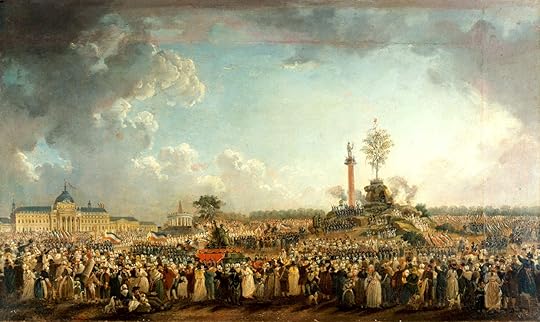
*
"... the dawning Republic One and Indivisible, of Liberty, Equality, Fraternity, or Death."
Dickens is quoting the motto adopted by the new French Republic.
*
"The escort were two mounted patriots in red caps and tri-coloured cockades..."
See Glossary - Chapter 21 - the group members are wearing the whole outfit.
*
“He is a traitor since the decree. His life is forfeit to the people. His cursed life is not his own!”
But emigrés returning to France did not face death until March 1793.
*
"... would find the people, in a ghostly manner in the dead of the night, circling hand in hand round a shrivelled tree of Liberty, or all drawn up together singing a Liberty song.
*
“Trees of Liberty" were popular symbols of the Revolution. The most famous, 60 feet high and topped by a red cap, stood in the Champ de Mars. The “Liberty song” is La Marseillaise, the French national anthem, which was composed during the Revolution and sung by French revolutionary forces.
La Carmagnole (chanson révolutionnaire)
http://www.youtube.com/watch?v=Q6dAV5...
http://en.wikipedia.org/wiki/Carmagnole
*
"You are consigned, Evremonde, to the prison of La Force."
Once an aristocratic residence, the Prison of La Force became a prison in 1780 and was a focus of the September massacres in 1792.

*
The horrible massacre, days and nights long, which, within a few rounds of the clock, was to set a great mark of blood upon the blessed garnering time of harvest, was as far out of his knowledge as if it had been a hundred thousand years away.
The notorious September massacres of 1792 consisted of summary executions of nearly 2,000 prisoners, male and female, in the four main Paris prisons. Carlyle devotes much space to this event in The French R evolution (1837), and historians consider it the single greatest atrocity of the Revolution, six days of murderous mayhem that are a chilling counterpart to the sustained, organized slaughter that took place during the Reign of T error (1793-1794). The victims included the Princesse de Lamballe, who was lynched in the massacres of September 1792. Her head was presented on a stake to her friend Marie-Antoinette.
A street scene during the massacres:

*
Modern guidebooks still point out the site of La Force. By placing Darnay in La Force in late August, 1792, Dickens makes him immediately vulnerable to the terrible “September massacres” of September 2-6.
http://dickens.stanford.edu/dickens/a...
*
"A man with a bloated face opened the strong wicket, to whom Defarge presented 'The Emigrant Evremonde. ' "
A wicket is a small gate or door, often “made in, or placed beside, a large one, for ingress and egress when the large one is closed” (OED).
 Chapter 2: The Grindstone
Chapter 2: The Grindstone"Tellson's Bank, established in the Saint Germain Quarter of Paris..."
The medieval quarter on the left bank of the River Seine, named for its famous church, Saint-Germain was once the preferred residence of aristocrats and has long been considered the heart of intellectual and cultural life in Paris.
*
" A mere beast of the chase flying from hunters, he was still in his metempsychosis:"
Metempsychosis refers to the transmigration of souls speculated upon by Greek philosophers.
*
"... would soon have driven the House out of its mind and into the Gazette"
The Gazette was the official public organ of the British government; it published news of military victories, but also contained lists of bankruptcies, the function alluded to here.
*
"The grindstone had a double handle, and, turning at it madly were two men, whose faces, as their long hair flapped back when the whirlings of the grindstone brought their faces up, were more horrible and cruel than the visages of the wildest savages in their most barbarous disguise. False eyebrows and false moustaches were stuck upon them, and their hideous countenances were all bloody and sweaty, and all awry with howling, and all staring and glaring with beastly excitement and want of sleep.
Dickens somewhat comically sanitizes a shocking incident during the September massacres, in which a gang of sans-culottes murdered the Princesse de Lamballe, decapitated her, then cut off her pubic hair and plastered it to their faces. Also, this blade sharpening is as close to the actual bloody fighting as Dickens gets.
 Chapter 4: Calm in Storm
Chapter 4: Calm in Storm "The new era began; the king was tried, doomed, and beheaded; the Republic of Liberty , Equality . Fraternity , or Death, declared for victory or death against the world in arms:"
Dickens now jumps ahead in time, past the execution of Louis XVI on January 21, 1793, to the crisis of February and March 1793, when the French army, now representing the revolutionary government, lost a series of battles to advancing Austrian and Prussian armies, prompting a massive call-up of reinforcements.
*
"The new Era began; the king was tried, doomed, and beheaded; the Republic of Liberty, Equality, Fraternity, or Death, declared for victory or death against the world in arms; the black flag waved night and day from the great towers of Notre-Dame; three hundred thousand men, summoned to rise against the tyrants of the earth, rose from all the varying soils of France."
The New Era – marked by the new Republican Calendar (the Revolutionary Calendar was in use until January 1, 1806), dated from the abolition of the monarchy, September 21, 1792. (Although the Calendar was not developed until the following year, the start of the New Era was backdated to the commencement of the Republic.) -
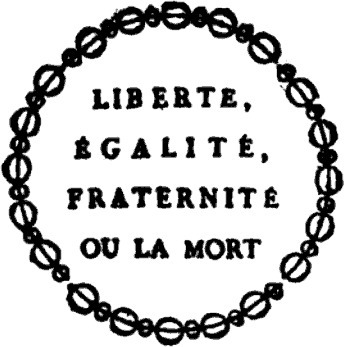
*
"... three hundred thousand men, summoned to rise against the tyrants or the earth, rose from all the varying soils or France, as if the dragons teeth bad been sown broadcast:"
According to the classical myth of the founding of Thebes, Cadmus killed a dragon and sowed its teeth into the earth, from which sprung an entire army .
*
"What private solicitude could rear itself against the deluge of the Year One of Liberty..."
The French Revolutionary Calendar, decreed on October 5, 1793, was computed retrospectively: “Year One” refers to the year beginning September 22, 1792, the day after the proclamation of the Republic.
*
"...the head of his fair wife which had had eight weary months of imprisoned widowhood and misery, to turn it grey..."
After the execution of the king, his queen, Marie-Antoinette, remained in prison until October 16, 1793, when she was finally brought to the guillotine.

"... law of the Suspected which struck away all security for liberty or life, .."
Anyone who was suspicious could be deemed “suspect” and imprisoned under the Law of Suspects which inaugurated a form of paranoid totalitarian state well known in the twentieth century. It was passed by the Revolutionary Convention on September 17, 1793, and resulted in the introduction of round-the-clock hearings at the Tribunal, and a tripling in both the prison population and the number of executions.
*
"... La Guillotine ... was bowed down to and believed in where the Cross was denied:
The French Revolution was deeply anticlerical in ideology, methods, and symbols. The divorce between church and state in France remains absolute.
*
"Twenty-two friends of high public mark, twenty-one living and one dead, it had lopped the heads off, in one morning, in as many minutes:"
The Girondins, the more moderate party that grew out of the Revolution, wished the king to be spared. They paid for their concern for Louis’s head with their own on October 31, 1793, when the radical Jacobins assumed full control of the state. One Girondin had committed suicide before his arrest but was beheaded anyway.
 Chapter 5: The Wood-sawyer
Chapter 5: The Wood-sawyer "One year and three months ... "
Dickens places Darnay’s arrest at the beginning of September 1792. Therefore, the action has now shifted to November 1793, during the Reign of Terror.
*
"On a lightly-snowing afternoon she arrived at the usual corner. It was a day of some wild rejoicing, and a festival. "
This winter day of “wild rejoicing” is probably based upon the festivities in November and December 1793 (Nov. 10?) , when – following the widespread renunciation by priests and curates of the Catholic religion (in favor of the “Fraternal embrace” and “no Religion but Liberty” – a procession of citizens, having despoiled the churches, jubilantly visited the National Convention.
*
"No fight could have been half so terrible as this dance. It was so emphatically a fallen sport – a something once innocent delivered over to all devilry – a healthy pastime changed into a means of angering the blood, bewildering the senses, and steeling the heart.... This was the Carmagnole."
Carmagnole describes both a French revolutionary song and dance, and the outfit (short jacket, tricolor waistcoat, long trousers) of those lower-class Parisians most likely to perform it.
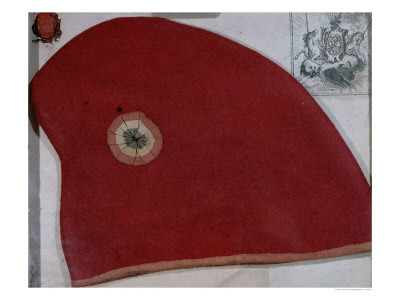
http://www.youtube.com/watch?v=Q6dAV5...
http://en.wikipedia.org/wiki/Carmagnole
(lyrics in French and English as well as background)
*
"He has not received the notice yet, but I know that he will presently be summoned for to-morrow, and removed to the Conciergerie..."
The Conciergerie was where the Revolutionary Tribunal heard cases against those charged with capital offenses against the state. Its most famous inmate was Marie- Antoinette, who displayed legendary grace and sang-froid for the term of her incarceration. It was located in the main prison adjoining the
Palais de Justice.
Palais de Justice.

 Chapter 6: Triumph
Chapter 6: Triumph "The dread Tribunal of five Judges, Public Prosecutor and determined Jury, sat every day."
The Revolutionary Tribunal, principal judicial organ of the Reign of Terror, was presided over by Antoine-Quentin Fouquier-Tinville. In accordance with the dark logic of the Terror, he ultimately went to the guillotine himself in May 1795.
*
"Charles Evremonde, called Darnay, was accused by the public prosecutor as an emigrant, whose life was forfeit to the Republic, under the decree which banished all emigrants on pain of Death."
On September 17, 1793, the Revolutionary government decreed that, according to a new “Law of the Suspect,” France be purged of its nobility (as Carlyle describes it, “…so has the Convention decreed: Let Aristocrats, Federalists, Monsieurs vanish, and all men tremble: ‘the Soil of Liberty shall be purged,’ – with a vengeance!” [667]). Darnay, entering France in August of 1792, returned before the laws under which he is tried had officially been passed.
*
" So quick was the Tribunal to compensate itself and the nation for a chance lost, that these five came down to him before he left the place, condemned to die within twenty-four hours. The first of them told him so, with the customary prison sign of Death—a raised finger—and they all added in words, "Long live the Republic!"
Dickens is probably referring to Madame Roland, a French Revolutionary, but not a Jacobin radical, who reportedly made some gesture to the crowd after her Tribunal hearing indicating that she had been condemned to death. Once on the scaffold, she uttered the famous words, “O Liberty! What crimes are committed in thy name!”
Before the Prison Tribunal by Phiz
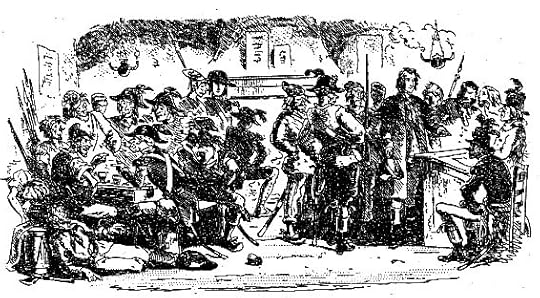
 Chapter 7: A Knock at the Door
Chapter 7: A Knock at the Door "... a blow was struck upon the door.
'Oh father, father. What can this be! Hide Charles. Save him!'
'My child,' said the Doctor, rising, and laying his hand upon her shoulder, 'I have saved him. What weakness is this, my dear! Let me go to the door.' "

Chapter 8: A Hand at Cards
"Happily unconscious of the new calamity at home, Miss Pross threaded her way along the narrow streets and crossed the river by the bridge of the Pont-Neuf... After peeping into several wine-shops, she stopped at the sign of The Good Republican Brutus of Antiquity..."
The Roman Brutus who helped expel the tyrants from Rome in 500 BC. This is now the sign on a Paris wine-shop.
*
"That somebody was assassinated by somebody vindicating a difference of opinion was the likeliest occurrence."
The most famous such assassination was that of the doctor and journalist Jean-Paul Marat, murdered in his bath on July 13, 1793. The incident might have been forgotten down the generations but for Jacques-Louis David’s iconic painting The Death of Marat (1793 .
Below - The Death of Morat by Jacques Louis David
(the artist was an ardent supporter of the Revolution including the Terror)

*
"Inference clear as day in this region of suspicion, that Mr. Barsad, still in the pay or the aristocratic English government, is the spy of Pitt...
Revolutionary France feared English intelligence agents from Prime Minister William Pitt were acting as provocateurs, inciting violence and confusion so as to destabilize the new government.
 Chapter 9: The Game Made
Chapter 9: The Game Made “ '...you know the consequences of mixing them?'"
The use of ether, which Sydney Carton appears to be planning to concoct, was first discovered and developed in France.
*
"...in the towers of the churches, where no prayers were said"
Anti-clericalism peaked at this period of the Revolution, with the enthronement of the “Goddess of Reason,” other churches were converted to workshops, prisons, and even taverns.
The Temple of Reason at Strasbourgh (there were many churches turned into Temples of Reason)

http://en.wikipedia.org/wiki/Temple_o...
Chapter 10: The Substance of the Shadow
"... Street of the School of Medicine..."
This street was home also to Jean-Paul Marat, stabbed to death in his bath at number 44 (see chapter 8, above).
*
"They have had their shameful rights, these Nobles, in the modesty and virtue of our sisters..."
Dickens is referring to the notorious droit de seigneur (see Book 2, Chapter 9 note)
Below, a Victorian artist's painting of an old man bringing his young daughters to their feudal lord.

*
"... pillaged and plundered to that degree that when we chanced to have a bit of meat, we ate it in fear..."
Apparently French peasants were forced to conceal what food they did have, and thus “ate it in fear” of punishment is a powerful indictment of the old French system, and suggests the total penetration of the domestic realm by the monitoring eye of the state.
*
"... sacrifices and self-immolations on the people’s altar..."
The Revolution very quickly took on the character of a cult, and adopted the trappings of religion. The first revolutionary altar was erected in the ruins of the Bastille, and was festooned with chains and manacles borrowed from its cells.
Perhaps the most famous altar was the Altar of the Fatherland – the “Autel de la Patrie” – erected in the Champ de Mars after the fall of the Bastille. This was where the petition was signed which eventually deposed Louis XVI.

*
"... Death within four-and-twenty hours!"
This was the standard capital sentence handed down by the Revolutionary Tribunal.
 Chapter 11: Dusk
Chapter 11: Dusk " 'I will go," said Doctor Manette, "to the Prosecutor and the President straight, and I will go to others whom it is better not to name.'"
Thomas Carlyle names Jean Bailly as the president although he was the mayor of Paris at the time. Bailly had been elected deputy from Paris to the Estates-General, he was elected president of the Third Estate in May 1789, led the famous proceedings in the Tennis Court in June, and - immediately after the storming of the Bastille - became the first mayor of Paris under the newly adopted system of the Commune.
http://en.wikipedia.org/wiki/Jean_Syl...
*
Chapter 12: Darkness
"... Madame Defarge returned to her counter to get the wine, and, as he took up a Jacobin journal... "
With their defeat of the Girondins, who had favored sparing the King, theJacobin press were now the ruling political entity in France.
*
Chapter 13: Fifty-two
"Two score and twelve were told off. From the farmer-general of seventy, whose riches could not buy his life, to the seamstress of twenty, whose poverty and obscurity could not save her."
The farmers-general included many liberal men sympathetic to the Revolution and some outstanding individuals, most notably the chemist Antoine-Laurent Lavoisier. All were sent, indiscriminately, to the guillotine.
*
"He wrote a long letter to Lucie..."
A letter of farewell was one of the few privileges granted to prisoners at the Conciergerie. Many of these letters survived and have been published.
*
Chapter 15: The Footsteps Die Out for Ever
"Six tumbrils carry the day’s wine to La Guillotine..."
The tumbrils began their journey at the Conciergerie, situated on the Ile de la Cité. They crossed north over either the Pont Neuf or Pont au Change, then headed west along the Rue Saint Honoré to the Place de la Révolution, where the guillotine awaited them. After the Terror subsided, the site was renamed Place de la Concorde. In the nineteenth century, the now familiar obelisk and fountains were brought to the site, further obscuring its bloody associations.
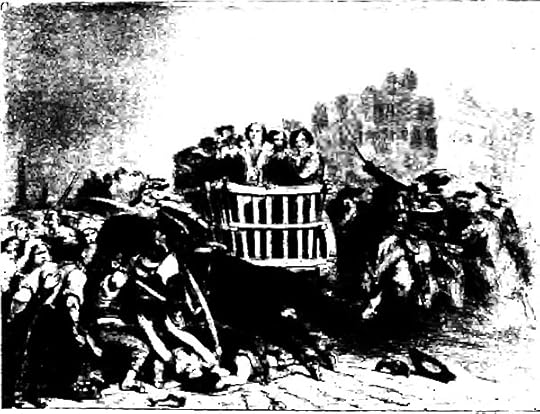
*
" One of the most remarkable sufferers..."
Dickens is thinking of Madame Roland, who, being denied on the scaffold the opportunity to write her final thoughts, proceeded to utter her famous indictment of the “Liberty” in whose name she was to be executed.
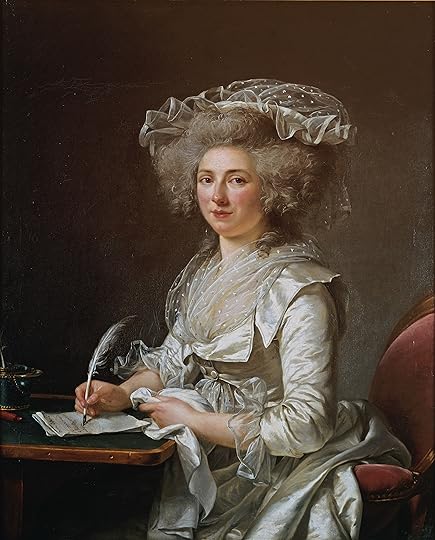
 A Tale of Two Cities: Historical Fiction
A Tale of Two Cities: Historical FictionFrom - http://www.victorianweb.org/authors/d...
In Aspects of the Novel (1927), novelist and critic E. M. Forster ... uses the metaphor of the novel as a valley or plain "bounded by two chains of mountains neither of which rises very abruptly--the opposing ranges of Poetry and History" (25). In an historical novel, argues Forster, the subject is not an historical event, "but memories, associations, passions, [which] rise up and cloud [the novelist's] objectivity" (36).
>>> snipped >>>
Since this is a story primarily designed to move the reader emotionally through a sympathetic identification with its characters, A Tale of Two Cities is not the collective memoirs of the Cruncher family, the Manettes, the Defarges, Sydney Carton, and Charles Darnay. As Forster points out, "A memoir is history, it is based on evidence. A novel is based on evidence + or -x, the unknown quantity being the temperament of the novelist" (55). A Tale of Two Cities is not a history of the French Revolution--that is partly why no historical characters actually appear in the story (the other reason is that Dickens distrusted the ideallism of such revolutionary leaders as Marat and Robespierre because of the monstrous deeds they justified in the name of Liberty); rather, it is the revelation of what Forster terms "the hidden life" of certain imagined characters who are reflections of the temperament of Dickens himself (notice, for example, that one of the book's protagonists has the initials "C. D." and that the model for Lucie was not merely Lucy Crayford in the melodrama The Frozen Deep, but also Dickens's extra-marital liaison, Ellen Ternan; furthermore, Dickens originally intended his chief protagonist to be named "Dick Carton").
What Dickens is ultimately concerned with in A Tale of Two Cities is not a particular historical event--that is simply his chosen dramatic setting--but rather the relationship between history and evil, how violent oppression breeds violent rebellion which becomes a new kind of oppression. His account of the ancien régime and the French Revolution is a study in civilized man's vocation for proliferating moral chaos, and in this one important regard the Tale is the most compellingly "modern" of his novels. (Alter 137)
More at - http://www.victorianweb.org/authors/d...
 Richard Grant White appraisal
Richard Grant White appraisalRichard Grant White, one of the leading literary critics in New York City argued that A Tale of Two Cities was a masterpiece: "Its portrayal of the noble-natured castaway makes it almost a peerless book in modern literature, and gives it a place among the highest examples of literary art. The conception of this character shows in its author an ideal of magnanimity and of charity unsurpassed. There is not a grander, lovelier figure than the self-wrecked, self-devoted Sydney Carton, in literature or history; and the story itself is so noble in its spirit, so grand and graphic in its style, and filled with a pathos so profound and simple, that it deserves and will surely take a place among the great serious works of imagination."
Books mentioned in this topic
The French Revolution: A History (other topics)The French Revolution: A History (other topics)
The French Revolution: A History (other topics)
The French Revolution: A History (other topics)
Charles Dickens's A Tale of Two Cities (other topics)
More...
Authors mentioned in this topic
Thomas Carlyle (other topics)Thomas Carlyle (other topics)
Thomas Carlyle (other topics)
Thomas Carlyle (other topics)
Harold Bloom (other topics)
More...




Chapter 10 Two Promises
"... before the setting in of the long vacation."
The annual “long vacation,” when the legal activity of the courts was suspended, ran from July to October; Michaelmas Term – the first term after the vacation – began on November 2nd.